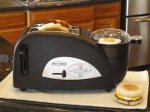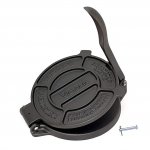- Joined
- Oct 9, 2017
- Messages
- 13,794
- Reaction score
- 7,497
- Gender
- Male
- Political Leaning
- Other
Pots, pans, baking pans, casseroles and other cooking implements:
The absolute best for a lifetime of daily cooking is stainless steel. Forget aluminum, nonstick, cast iron and every other trendy substances. Aluminum is a reactive metal, and like tin, brass, bronze will effect the flavor of foods. Avoid like the plague. Same with nonstick substances that scratch during cleaning and leech toxins into what you are eating. There isn't one non stick substance which doesn't suffer this problem, no matter what the ads say. They all lie. Caveat Emptor.
Cast iron, originally intended for use with open fires, coal and wood burning stoves, stood capable of high heat without falling apart. Properly seasoned, meaning the surface has been carbonized over time with cooking oils, is non-stick, but can never truly be cleaned for fear of breaking the seasoning, and sterility is dependent upon bringing the pan or pot to high heat before adding fresh food for cooking. They will smoke, and so will food at high temperatures. Any kitchen using cast iron could develop the aroma of a greasy spoon. The chief advantage of cast iron is cooking at extremely high temperatures, which can also be achieved with stainless steel and not all the smoke.
The best stainless steel pots and pans have a thin layer of copper between the pot or pan bottom and the cooking surface. This insures even heating at all temperatures thanks to the conductivity of copper. Today, because of the increased costs of copper aluminum has become the insert of choice. Not as efficient as copper, and not a problem because it does not come in contact with the food, it works. I've a collection of these types of pots and pans, about 35 different sizes, styles and purposes. Fry pans, sautéing pans, double boilers, pasta pots of different sizes, sauce pans, stew pots, and so on. All but a 5 piece starter set received as a wedding present with my first wife, bought at tag sales and so on, average at 10¢ on the original $ cost. When I shop the various sales, I keep a small piece of shredded steel cleaner in my pocket to rub away a patch of build up to identify the type of insert, no one cares about a touch of spot cleaning, and if it is copper I buy.
New 10 piece starter sets vary in price from about $250 to $3k. Unless you have money to burn, will never cook in them and want a photo of your kitchen in Architectural digests, a $250 starter set gets the job done.
I'm an avid baker, casserole maker, and roaster. I have about 120 baking pans, cookie sheets, cooling racks, casserole dishes, roasting pans, made from stainless steel, ceramic and glass. For the most part all have been bought at second hand sales, or while traveling overseas for specialty items, usually glazed specialty ceramics for ethnic foods. Many, I've picked up for $1 or 2. Other people's junk, my treasures. Anything from glass or ceramics I stick to the Corning label, to assure myself of oven quality. I use a magnifying glass to search for hairline scratches and cracks, and if absent, I buy. I make look silly when I examine products with my little pocket magnifier, but I don't bring anything home to throw away. One of my prize purchases, a Corning glass lidded Turkey Roaster, big enough for a 30lb Turkey with accouterments, for $5. Never used. Picked up at a tag sale, and used for all kinds of roasts over the years, including a 32lb elk loin roast that fed a wedding party of 60. All we needed was a groom and bride, a reaffirmation of vows at a 50th anniversary, they both fell asleep before the ceremony. It was still fun, and the ceremony took place after the dinner. We kept warmer plates for the both of them.
The absolute best for a lifetime of daily cooking is stainless steel. Forget aluminum, nonstick, cast iron and every other trendy substances. Aluminum is a reactive metal, and like tin, brass, bronze will effect the flavor of foods. Avoid like the plague. Same with nonstick substances that scratch during cleaning and leech toxins into what you are eating. There isn't one non stick substance which doesn't suffer this problem, no matter what the ads say. They all lie. Caveat Emptor.
Cast iron, originally intended for use with open fires, coal and wood burning stoves, stood capable of high heat without falling apart. Properly seasoned, meaning the surface has been carbonized over time with cooking oils, is non-stick, but can never truly be cleaned for fear of breaking the seasoning, and sterility is dependent upon bringing the pan or pot to high heat before adding fresh food for cooking. They will smoke, and so will food at high temperatures. Any kitchen using cast iron could develop the aroma of a greasy spoon. The chief advantage of cast iron is cooking at extremely high temperatures, which can also be achieved with stainless steel and not all the smoke.
The best stainless steel pots and pans have a thin layer of copper between the pot or pan bottom and the cooking surface. This insures even heating at all temperatures thanks to the conductivity of copper. Today, because of the increased costs of copper aluminum has become the insert of choice. Not as efficient as copper, and not a problem because it does not come in contact with the food, it works. I've a collection of these types of pots and pans, about 35 different sizes, styles and purposes. Fry pans, sautéing pans, double boilers, pasta pots of different sizes, sauce pans, stew pots, and so on. All but a 5 piece starter set received as a wedding present with my first wife, bought at tag sales and so on, average at 10¢ on the original $ cost. When I shop the various sales, I keep a small piece of shredded steel cleaner in my pocket to rub away a patch of build up to identify the type of insert, no one cares about a touch of spot cleaning, and if it is copper I buy.
New 10 piece starter sets vary in price from about $250 to $3k. Unless you have money to burn, will never cook in them and want a photo of your kitchen in Architectural digests, a $250 starter set gets the job done.
I'm an avid baker, casserole maker, and roaster. I have about 120 baking pans, cookie sheets, cooling racks, casserole dishes, roasting pans, made from stainless steel, ceramic and glass. For the most part all have been bought at second hand sales, or while traveling overseas for specialty items, usually glazed specialty ceramics for ethnic foods. Many, I've picked up for $1 or 2. Other people's junk, my treasures. Anything from glass or ceramics I stick to the Corning label, to assure myself of oven quality. I use a magnifying glass to search for hairline scratches and cracks, and if absent, I buy. I make look silly when I examine products with my little pocket magnifier, but I don't bring anything home to throw away. One of my prize purchases, a Corning glass lidded Turkey Roaster, big enough for a 30lb Turkey with accouterments, for $5. Never used. Picked up at a tag sale, and used for all kinds of roasts over the years, including a 32lb elk loin roast that fed a wedding party of 60. All we needed was a groom and bride, a reaffirmation of vows at a 50th anniversary, they both fell asleep before the ceremony. It was still fun, and the ceremony took place after the dinner. We kept warmer plates for the both of them.






